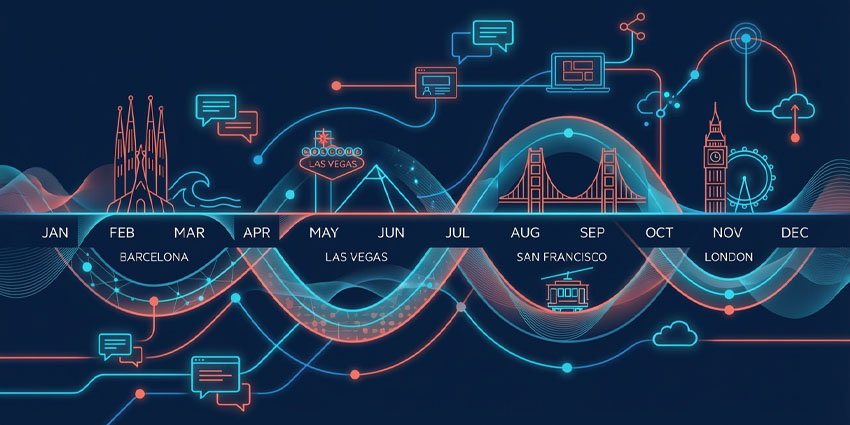The landscape of unified communications has fundamentally shifted. Gone are the days when UC and Collaboration were exclusively the domain of telecom specialists and AV pros. Today’s UC stack demands a new breed of IT professional—one who can navigate both traditional infrastructure and cutting-edge cloud platforms.
While UC remains something of a grey art, the game has changed. The old model, one platform trying to do everything, with rigid contracts and slow updates, is fading out. Cloud architecture and flexible codebases have simplified some things. But the scope has expanded massively. IT leaders are juggling a growing ecosystem of tools, from messaging apps, to meeting room hardware, and AI systems.
This shift is driving serious investment. The unified communications market is sprinting towards a projected value of $417.86 billion by 2030. For enterprise teams, staying ahead isn’t just about buying the latest tools; it’s about building a communication setup that actually fits how your people work.
If you’re planning, buying, or rebuilding your unified communication system, use this as your UC buyer guide. The right stack doesn’t just save time or money. It helps your teams do better work, and it keeps your customers coming back.
New to UC? Start with our Ultimate UC guide
The Modern UC Stack: Understanding the Market
The UC market is bursting with innovation, fueled by hybrid work, cloud-first strategies, AI and 5G. UC overall is grabbing massive market attention, but the UCaaS segment – arguably the engine behind the modern UC stack is growing even faster, at a rate of 19.8% CAGR.
The usual heavyweights still dominate much of the market: Microsoft, Cisco, RingCentral, and Zoom. In North America, cloud-based UC has passed the 50% adoption mark. Over in Asia Pacific, growth is even more aggressive, with some regions seeing over 20% year-on-year expansion.
But it’s not just about market size. Expectations have changed. IT leaders aren’t shopping for a messaging app or a video tool, they’re building integrated systems. They want unified communication solutions that pull in real-time analytics, support regulatory compliance, and play nicely with the rest of their tech stack.
When we talk to enterprise buyers, most of them are thinking about the same big questions:
- What’s the total cost difference between cloud and on-prem over five years?
- How locked in will we be if we pick this vendor?
- Can we meet compliance requirements: GDPR, HIPAA, voice retention, without bolt-on tools?
- Is this platform ready for AI? Can it help us predict, not just react?
Core Components of the UC Stack
There’s no universal blueprint for a UC stack. Not anymore. What works for one organization might be totally wrong for another. The best stacks are built in layers, voice, video, messaging, collaboration, contact center, management, and AI all working together, not just sitting side by side.
Let’s look at some of the core components.
The Foundation: UCaaS (Unified Communications as a Service)
Your command center for enterprise communication. UCaaS consolidates voice, video, messaging, and presence into one cloud-based platform. Think Microsoft Teams, Zoom, or RingCentral – but it’s not just about picking a platform, it’s about architecting a solution that scales with your business demands. More than 70% of enterprises in North America now rely on UCaaS as their primary platform
But platform selection is only step one. You need to consider voice compliance, network resilience, hybrid integration, and vendor roadmaps. Prioritize platforms that offer open APIs, native analytics, and AI-native features.
Meeting Rooms and Devices
In the UC stack, meeting rooms and devices are the hardware backbone that brings your virtual collaboration to life. From smart cameras that track speakers to room systems that fire up with one touch, this layer bridges the gap between physical and digital workspaces. Pro tip: standardization across rooms reduces IT headaches and user friction.
Endpoint evolution is everywhere. Tools like Zoom Rooms, Microsoft Teams Rooms, and Logitech Rally Bar are now expected to offer AI-based camera framing, real-time transcription, and automated diagnostics out of the box.
Project Management Integration
This isn’t your father’s project management. Modern UC stacks weave project tools directly into communication flows. When Asana or Monday.com tasks pop up in Teams channels, you’re looking at the future of work in action.
With hybrid and async work in full swing, task visibility inside communication channels is a game-changer. Microsoft Loop and Slack Canvas are also blurring the lines between messaging, project tracking, and document collaboration.
Workplace Management
The command bridge for your hybrid workforce. This layer handles everything from desk booking to meeting room analytics. It’s about making your physical and digital workspaces play nice together, maximizing both real estate ROI and employee satisfaction.
The shift toward hybrid has driven a surge in smart workplace platforms. Tools like Envoy, Condeco, and Robin now offer analytics on workspace usage, occupancy trends, and even air quality.
CCaaS (Contact Center as a Service)
Customer experience meets employee empowerment. Modern contact centers aren’t phone banks – they’re AI-powered engagement hubs that integrate seamlessly with your UC stack. Your agents get context, customers get resolution, and everybody wins.
Today, more than 40% of enterprises prioritize UCaaS–CCaaS convergence to unify internal and external communications. Vendors like NICE, Genesys, and Talkdesk are leading this push with AI-first platforms.
CPaaS (Communications Platform as a Service)
The secret sauce for custom communication workflows. Need to embed video calls in your app? Want to trigger SMS alerts based on customer behavior? CPaaS is your toolkit for building communication features that give you the edge.
Twilio, Vonage, and Sinch continue to lead in programmable APIs, but now offer prebuilt workflows and AI integrations. Think drag-and-drop call routing or real-time voice transcription, with no need to build from scratch.
Collaboration Displays
The visual frontier of team collaboration. From digital whiteboards to immersive video walls, these aren’t just screens – they’re portals for creativity and connection. When remote teams can sketch ideas together like they’re in the same room, you know you’re doing something right.
The interactive display market is set to grow to a value of $86.44 billion by 2030. Options like Google Series One and Neat Board bring AI, voice control, and better video framing into the mix.
UC Service Management
Let’s get real – enterprise UC environments are never straightforward. Modern UC management tools are stepping up to tackle this complexity head-on. They’re bringing advanced capabilities for:
- Global SIP network management: Centralizing control over number provisioning and SIP trunking across regions
- Multi-UC environment support: Because most enterprises run hybrid environments, these tools handle migrations and management across multiple UC platforms simultaneously
- Automation and orchestration: Streamlining provisioning, configuration changes, and policy management across your entire UC ecosystem
- Performance monitoring: Real-time analytics and troubleshooting across your global communication infrastructure
Look for solutions that support role-based access, cross-platform scripting, and native API connectors.
The AI Revolution: The Invisible Layer
Artificial Intelligence isn’t just another layer – it’s the neural network running through your entire stack. Here’s where it’s making waves:
- Meeting Intelligence: Real-time transcription, action item extraction, and sentiment analysis
- Smart Scheduling: AI assistants that handle the calendar tetris
- Predictive Analytics: Spotting communication patterns and potential bottlenecks before they impact productivity
- Enhanced Customer Experience: From intelligent routing to real-time translation
- Security and Compliance: AI-powered threat detection and compliance monitoring
AI is baked into nearly every major UC tool today, from Microsoft Copilot to Zoom AI Companion. Expect AI features to become table stakes rather than differentiators.
- Learn all about the impact of AI in UC in this report
The Importance of CX & EX in the Modern Workplace
The modern UC stack isn’t just about technology – it’s about experiences. Customer Experience (CX) and Employee Experience (EX) have become central to UC strategy, transforming how we think about communication infrastructure.
Smart organizations are leveraging their UC stack to create seamless experiences across both customer and employee touchpoints. Contact center agents get contextual customer data at their fingertips. Employees access enterprise-grade communication tools from any device or location. The result? Higher satisfaction scores, better retention rates, and improved productivity across the board.
The convergence of CX and EX through unified communications is creating a virtuous cycle: empowered employees deliver better customer experiences, while satisfied customers make for more engaged employees. That virtuous cycle isn’t abstract.
Teams work better when their tools talk to each other. According to Metrigy’s 2024 Workplace Collaboration report, organizations with tightly integrated UC tools and customer-facing platforms saw a 25% boost in employee satisfaction and a 17% lift in NPS.
For IT and procurement teams, this means looking beyond feature checklists. Can your tools share context between support and sales? Will frontline workers be able to securely message HQ without jumping through hoops? Can teams move between apps without logging in five times?
UC Stack Best Practices & Implementation Strategy
Rolling out a new UC stack can feel like solving a Rubik’s Cube while the colors keep changing. There are a lot of moving parts: platform selection, migration, user adoption, integrations, security, and ongoing management. The trick is to treat it like a transformation project, not just a tech refresh.
Start with People, Not Platforms
One of the most common mistakes? Picking tools before understanding how people actually work. Interview users across roles and regions. Watch how teams collaborate. Do they live in chat? Are meetings bloated or scattered across tools? What breaks down most often? This insight should drive your UC stack design, because if it doesn’t solve real workflow pain, it won’t stick.
Align IT and Business Goals Early
It’s easy to get distracted by exciting new features, like agentic AI, or immersive meetings. Stay focused on the bigger picture. What are the business outcomes you want? Reduced churn? Better collaboration between remote teams? Faster onboarding? Tie those goals to the unified communication solutions you’re evaluating. If you can’t trace a feature back to a business benefit, think twice.
Don’t Underestimate Change Management
A new UC toolkit doesn’t magically create a new behavior. You’ll need a real rollout plan: pilot groups, feedback loops, internal champions, training sessions, and yes, a bit of handholding. IT leaders who skip this phase usually regret it. Adoption isn’t a one-time event. It’s a process.
Prioritize Open, Flexible Architecture
Choose a UC stack that can evolve. The goal isn’t to futureproof everything, it’s to avoid painting yourself into a corner.
Look for:
- Open APIs
- App marketplaces or native integrations
- Real-time analytics
- Configurable admin policies
- Support for hybrid deployments
Don’t forget about governance. Features like provisioning automation, audit logs, and policy enforcement across tools are essential at scale.
The New UC Stack: ROI & Business Impact
A well-built UC stack doesn’t just improve conversations. It reshapes how your entire business operates: how fast decisions get made, how well customers are supported, and how confident teams feel using their tools.
But you can’t measure that with call logs alone. ROI from unified communications shows up in places that don’t always look technical on the surface:
Time Saved Is Value Created
The average person toggles between tools 1,200 times per day. When your unified communication system brings those tools together: voice, messaging, video, documents, you win that time back.Let’s say your new stack reduces context-switching by just 15 minutes a day per user. Multiply that across 1,000 employees and you’re talking about more than 3,000 hours a month reclaimed.
Cost Reduction Without Cutting Corners
Cloud-based UC tools offer clear savings on infrastructure and maintenance. No hardware refresh cycles, servers to patch, or on-site provisioning. However, the real value lies in consolidation.
If your stack replaces six disconnected platforms with one well-integrated suite, you’re cutting software costs, support overhead, and admin complexity in one move. One study found that by switching to one platform for all communications, companies could save around $2.68 million.
Experience Drives Retention
There’s a strong connection between communication tools and how people feel about their jobs and your brand. Employees with access to modern UC tools and a unified UC stack are more efficient, productive, and engaged. That means they’re also more effective at serving and supporting customers, with context, personalization, and empathy. If your UC stack improves both EX and CX at the same time, you’re not just saving money. You’re building loyalty.
Ready to start exploring the top UC solution vendors and systems?
Start with our market maps for everything from UCSM, to meeting rooms, and UCaaS platforms.
The UC Stack is Changing: Evolve With It
Your UC stack is more than infrastructure; it’s the backbone of your digital workplace strategy. Get it right, and you’ll unlock levels of collaboration and productivity that were science fiction a decade ago. There’s no single blueprint. What works for a global law firm won’t look the same for a high-growth SaaS startup or a national healthcare provider.
But the key themes apply across the board: flexibility, integration, visibility, and experience. Modern unified communication solutions give you the tools, but your stack is the strategy.
If you build it with intention, you’ll avoid the typical pain points: shadow IT, platform fatigue, messy migrations, and high churn. Instead, you’ll create a unified communication environment that feels natural to use and easy to manage.
Dive Deeper: State of UC 2024 Report
Want to benchmark your UC strategy against industry leaders? Our unique reports delivers crucial insights from over 500 industry professionals, mapping out trends and strategic directions that will shape the year ahead. Download your free copy of the latest research to inform your UC roadmap with data-driven insights from the frontlines.
Ready to level up your UC game?
Join our community of IT leaders and UC pros at UC Today Community. Check out upcoming events for an opportunity to test the latest innovations hands-on, or stay ahead of the curve by subscribing to our weekly newsletter.
Want to dive in? Start with our ultimate UC Buyer’s guide.







